We’ve all been there – standing in our laundry room wondering how such a small space can feel so chaotic. Between overflowing baskets scattered cleaning supplies and that mysterious pile of single socks we’re drowning in laundry room clutter. But what if we told you that transforming this overlooked space into an organized haven is easier than you think?
A well-organized laundry room doesn’t just look beautiful – it saves us precious time and reduces daily stress. When everything has its designated place we can breeze through our weekly washing routine instead of hunting for detergent or untangling hangers. The best part? You don’t need a massive budget or complete renovation to achieve laundry room bliss.
We’re about to share proven strategies that’ll turn your chaotic laundry space into an efficient organized zone where every item serves a purpose. Ready to reclaim your sanity and create a room you’ll actually enjoy spending time in?
Declutter Your Laundry Room for Maximum Efficiency
Starting fresh requires us to remove everything from our laundry room first. Empty out all cabinets, shelves, and drawers to see exactly what we’re working with. This complete removal gives us a clear picture of our space and helps identify items we’ve forgotten about.
Sort items into three distinct categories:
- Keep: Products we use regularly like detergent, fabric softener, and stain removers
- Donate: Items in good condition that we no longer need such as extra hangers or unused cleaning supplies
- Toss: Expired products, broken items, and anything beyond repair
Check expiration dates on all cleaning products since many people keep laundry supplies for years without realizing they lose effectiveness. Liquid detergents typically last 6 to 12 months while powder detergents can last up to 2 years when stored properly.
Count how many of each item we actually need to avoid future overcrowding. Most households only require one backup bottle of detergent and fabric softener. Multiple half empty containers of the same product create unnecessary clutter and waste valuable storage space.
Remove these common laundry room clutter culprits:
- Single socks without matches that have been waiting for reunification for over 6 months
- Cleaning products we bought but never used because they didn’t work as expected
- Broken laundry baskets that we keep meaning to repair
- Old rags and towels beyond their useful cleaning life
- Hangers we’ve accumulated from dry cleaning that we never actually use
Focus on keeping only items that serve our current laundry routine needs. Every product should have a exact purpose and regular use in our washing process. This approach prevents our newly organized space from becoming cluttered again within weeks of our initial cleanup effort.
Group similar items together during the sorting process to see how much we really have of each category. We often discover we own multiple bottles of the same stain remover or fabric softener without realizing it.
Sort and Categorize Your Laundry Supplies
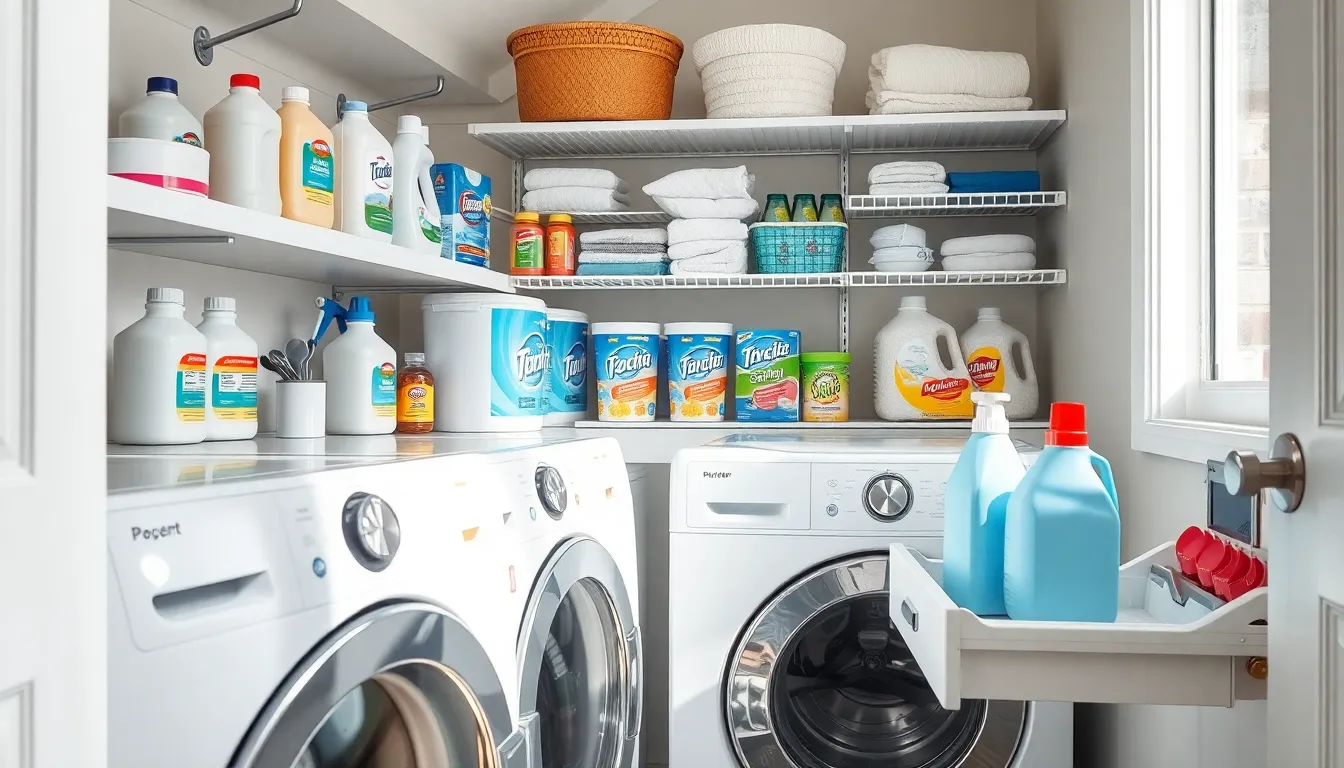
Now that we’ve cleared out the clutter, it’s time to organize what remains into logical groups that make laundry day more efficient.
Group Cleaning Products by Function
Detergents deserve their own designated space where we can easily grab what we need for each load. Store liquid detergents on one shelf and powder formulations on another to prevent confusion during busy mornings.
Fabric softeners and dryer sheets work together for clothing care, so we keep them in a single area near the dryer. Liquid softeners go on lower shelves since they’re heavier, while dryer sheets can occupy higher storage spots.
Pre-treatment products need immediate accessibility because stains wait for no one. We position stain removers, bleach alternatives, and spot treatments in a front-facing location where we can quickly identify the right product for each fabric emergency.
Specialty cleaners require separate storage from everyday products to prevent mix-ups. Delicate fabric washes, wool cleaners, and color-safe bleaches get their own section away from regular detergents.
Separate Daily Use Items from Seasonal Supplies
Everyday essentials earn prime real estate in our laundry room organization system. We place frequently used detergent, fabric softener, and stain remover at eye level for effortless access during weekly wash routines.
Seasonal items move to higher shelves or storage containers until their time arrives. Heavy-duty stain removers for outdoor activities, swimsuit care products, and winter fabric protectors can wait in less accessible spots.
Measuring cups and scoops stay with daily supplies since we use them constantly. We attach these tools to detergent containers or keep them in nearby drawers to streamline our washing process.
Backup supplies go behind current products using a first-in, first-out rotation system. This prevents us from buying duplicates while ensuring we never run out of essential cleaning products.
Organize Stain Removal Tools and Treatments
Stain removal tools need their own command center for quick response to fabric disasters. We create a designated drawer or shelf area that houses brushes, scrapers, and applicator bottles in one convenient location.
Treatment products require categorization by stain type to speed up our response time. Protein stain removers, grease fighters, and ink eliminators each get labeled sections so we can grab the right solution immediately.
Pre-treatment sprays and gels deserve front-row placement since we use them most frequently. We position these products at the front of our stain removal station for instant access when accidents happen.
Specialty tools like stain removal pens and portable sprays travel with us throughout the house, but they need a home base in the laundry room. We designate a small basket or container where these mobile stain fighters return after each use.
Create Designated Storage Zones

Now that we’ve decluttered and grouped our supplies, it’s time to establish exact zones that’ll streamline our laundry routine and keep everything in its proper place.
Establish a Detergent and Fabric Softener Station
Designate a dedicated shelf or area specifically for all your washing products. Position liquid detergents, powder detergents, and fabric softeners on the same shelf to create a one-stop washing station. Keep measuring cups or dispensers with built-in measuring capabilities nearby to simplify the dosing process during each load.
Store these products at eye level whenever possible. This placement reduces bending and stretching while making it easier to read labels and check product levels. Consider using a lazy Susan or turntable for corner spaces to maximize accessibility.
Group similar products together using clear containers or baskets. Place all liquid products in one container and powders in another to prevent spills and keep everything contained. Label each container clearly so family members know exactly where each product belongs.
Design a Folding and Sorting Area
Create a dedicated surface for folding clothes by adding a countertop or table. Install a bamboo countertop over your washer and dryer to maximize vertical space while providing a sturdy folding surface. This addition transforms unused space into a functional work area.
Position sorting baskets or bins near your folding station. Use separate containers for different family members or clothing types like delicates, darks, and lights. This system allows you to sort items immediately as you fold them.
Keep folding essentials within arm’s reach of your work surface. Store hangers, fabric spray, and lint rollers in nearby drawers or on mounted shelves. Having these tools close by eliminates trips across the room during the folding process.
Set Up a Lost Sock Collection Point
Designate a small basket or mesh bag specifically for collecting single socks. Place this container in a visible location near your dryer to catch missing socks before they disappear completely. This simple system prevents the frustration of searching through loads for missing pairs.
Check your sock collection point regularly during laundry days. Reunite pairs immediately when both socks surface, and consider donating or repurposing socks that remain single after several weeks.
Use a clear container so you can easily see the contents. This visibility helps you quickly identify when a matching sock appears and prevents the collection from becoming overwhelming.
Maximize Vertical Space with Smart Storage Solutions
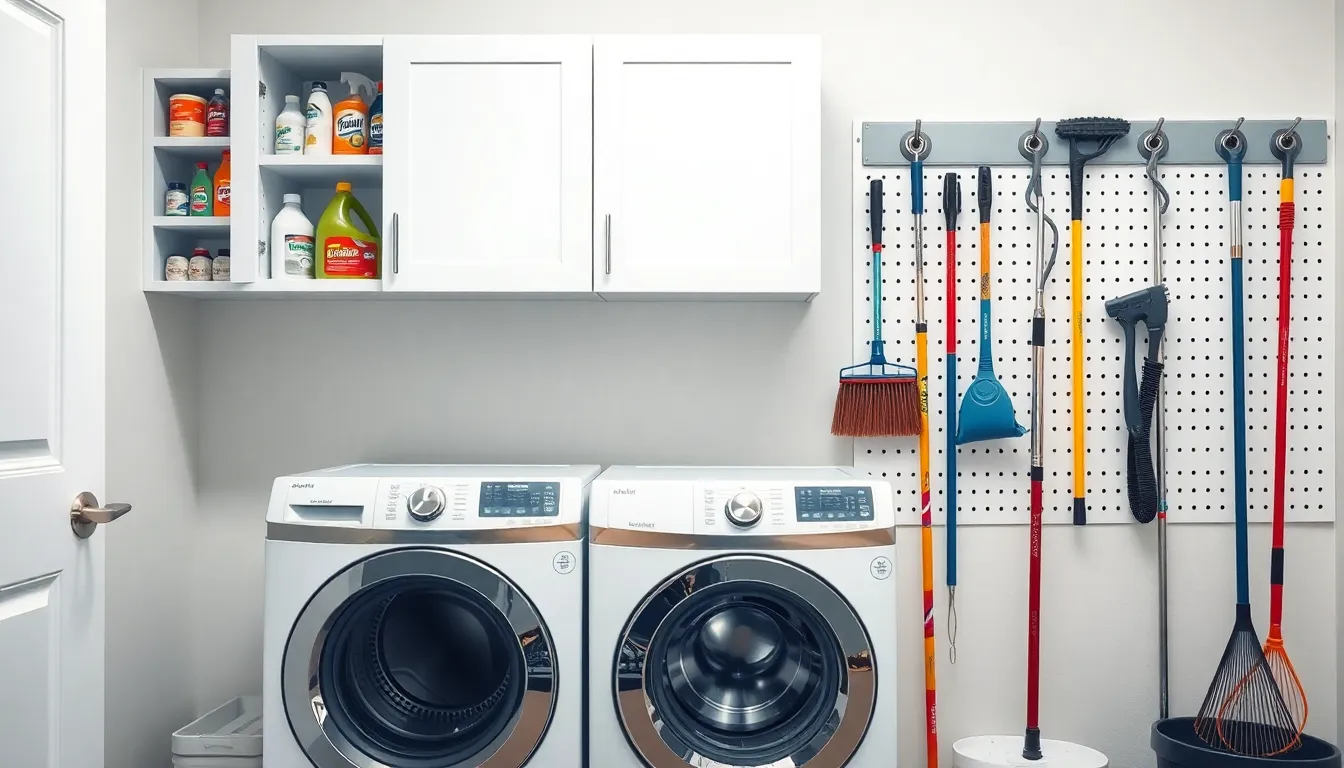
Wall mounted shelving systems transform unused wall space into valuable storage real estate for our laundry supplies. These systems provide additional storage for detergents and other essentials while keeping them off the floor and out of the way.
Install Wall-Mounted Shelving Systems
Installing wall mounted shelving systems creates instant storage without sacrificing floor space in our laundry room. Floating shelves work perfectly for storing detergent bottles, fabric softener containers, and dryer sheets at eye level for easy access. Metal wire shelving systems offer durability and allow us to see through to items stored behind, making inventory management effortless.
Adjustable bracket systems let us customize shelf heights to accommodate different sized laundry products like tall bleach bottles or wide fabric softener jugs. We can position these shelves above our washer and dryer or along empty wall sections to maximize every inch of vertical space. Corner shelving units make excellent use of often forgotten spaces while keeping frequently used supplies within arm’s reach.
Add Over-the-Washer Storage Cabinets
Over the washer storage cabinets make efficient use of the space above our appliances by storing items like detergent, fabric softener, and cleaning supplies. Cabinet doors keep these products dust free while creating a clean, streamlined appearance in our laundry room. Deep cabinets accommodate bulk sized detergent containers and multiple cleaning products without overwhelming the space.
Upper cabinets with soft close hinges prevent slamming and protect both the cabinet and stored items from damage. We can install these cabinets to match our existing cabinetry or choose open shelving styles for easier access to daily use products. Interior cabinet organizers like lazy Susans and pull out drawers help us reach items stored in the back without having to remove everything in front.
Use Pegboards for Hanging Cleaning Tools
Pegboards mounted on walls provide organized storage for brooms, mops, and dustpans while keeping them easily accessible. Custom hooks and holders let us hang spray bottles, scrub brushes, and other cleaning tools in designated spots. This system keeps our floor clear and prevents cleaning tools from falling over or getting buried behind other items.
Colored pegboard hooks help us create a visual organization system where each tool has its designated spot. We can add small baskets to hold cleaning cloths, sponges, and other lightweight supplies directly on the pegboard. Multiple pegboards can be arranged side by side to create a comprehensive cleaning tool storage wall that grows with our needs.
Optimize Floor Space with Strategic Placement
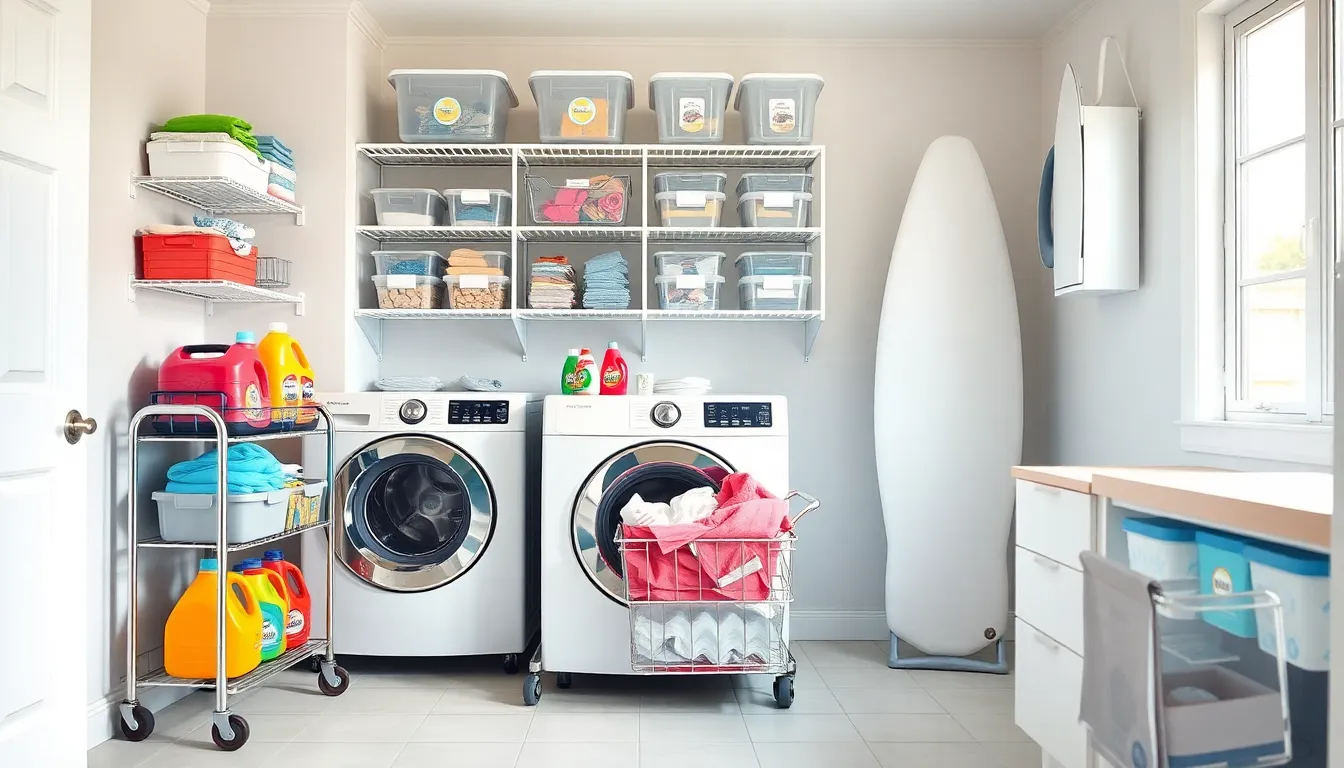
Strategic placement transforms cramped laundry rooms into efficient workspaces by maximizing every square foot. Smart positioning of equipment and storage answers creates more room for movement while maintaining full functionality.
Position Rolling Laundry Carts for Easy Movement
Rolling laundry carts offer exceptional flexibility for transporting clothes and supplies throughout your laundry room. We recommend selecting carts with smooth-rolling wheels that can navigate tight spaces without damaging walls or appliances. These mobile units work particularly well in small laundry rooms where fixed storage might block pathways.
Multi-level carts provide the best value by creating separate compartments for dirty clothes, clean laundry, and folding supplies. Position your cart near the washer for easy loading, then roll it to the dryer or folding area as needed. This mobility eliminates the need to carry heavy baskets across the room multiple times during each laundry cycle.
Carts also serve as temporary folding stations when counter space is limited. Simply roll the cart to an open area and use the top surface for sorting and folding clothes. When not in use, tuck the cart into corners or beside appliances to keep walkways clear.
Create Stackable Storage for Bulky Items
Stackable storage answers maximize vertical space while keeping bulky detergent containers and cleaning supplies organized. Clear plastic bins work best because they allow quick identification of contents without removing lids or moving containers. We suggest measuring your shelf heights before purchasing to ensure bins stack properly without wasting space.
Label each container clearly to maintain organization and help family members return items to their designated spots. Group similar products together, such as stacking all fabric softeners in one area and detergents in another. This system prevents confusion and reduces time spent searching for exact products.
Heavy items should occupy bottom containers to prevent toppling, while lighter seasonal items can stack higher. Reserve top containers for items used less frequently, such as specialty stain removers or seasonal cleaning supplies. This arrangement keeps everyday essentials within easy reach while maximizing storage capacity.
Designate Space for Ironing Board Storage
Ironing board storage requires dedicated space to prevent equipment from becoming obstacles or safety hazards in your laundry room. Wall-mounted ironing board cabinets offer the most space-efficient solution by keeping boards completely out of sight when not in use. These cabinets integrate seamlessly with existing cabinetry and eliminate the need for separate storage areas.
Pullout drawer systems work well in custom cabinetry installations where wall mounting isn’t possible. These drawers slide out smoothly and support full-sized ironing boards without requiring additional floor space. Install these systems at comfortable heights to avoid bending or stretching during setup.
Multi-purpose islands provide an alternative solution when space allows. These units combine ironing board storage with additional counter space for folding and sorting clothes. The consolidated workspace eliminates the need to move between different areas during laundry tasks, creating a more efficient workflow in your organized laundry room.
Implement a Functional Sorting System
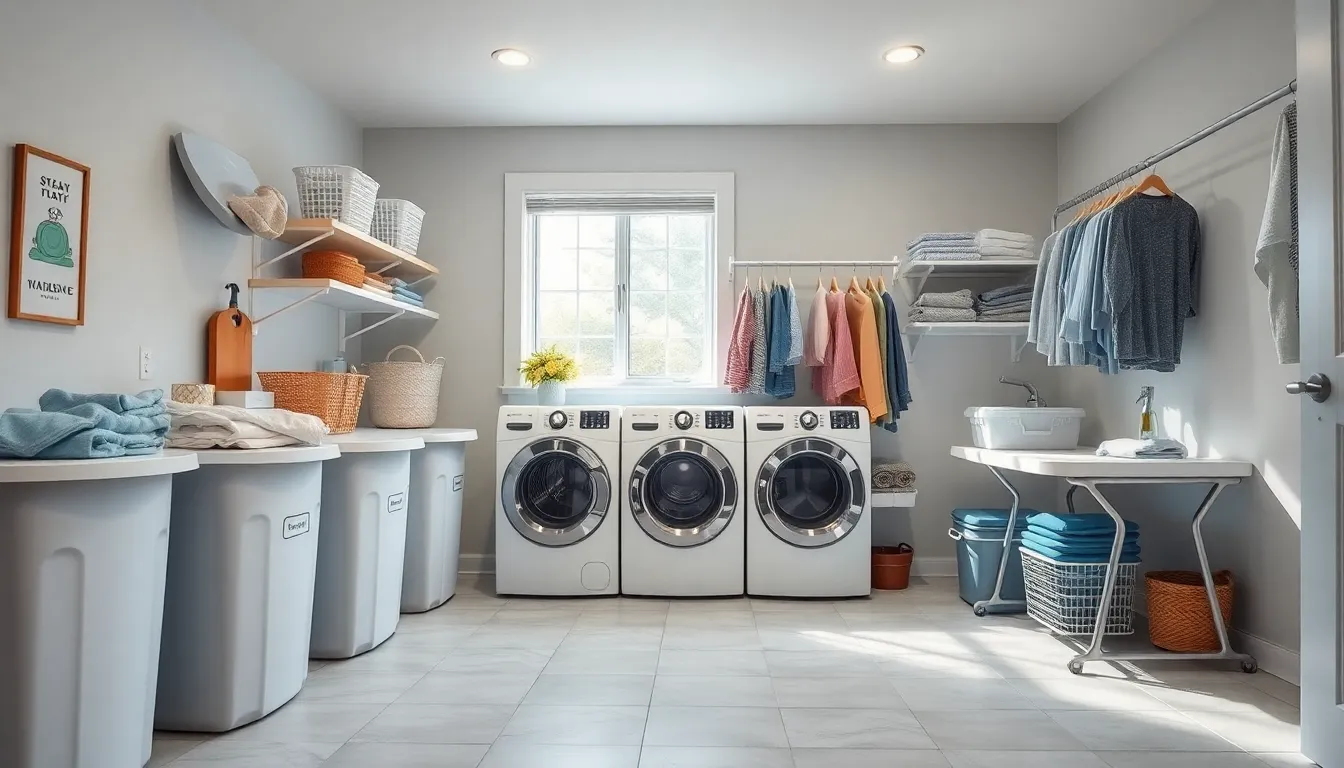
Creating an organized sorting system transforms our laundry routine from chaotic to streamlined. We’ll establish dedicated spaces that make washing, treating, and processing clothes more efficient.
Set Up Multiple Hampers for Different Fabric Types
Delicate items deserve their own designated hamper to prevent damage from heavier fabrics. We recommend placing a mesh laundry bag or soft sided bin specifically for lingerie, silk, and wool pieces that need gentle care.
Light colored clothing gets sorted into a separate container for whites, pastels, and light colored garments. This prevents color bleeding and ensures our brightest items stay vibrant wash after wash.
Dark colored items need their own space to avoid transferring dyes to lighter fabrics. We suggest using a hamper labeled specifically for black clothes, dark colors, and heavily soiled work clothes.
Whites and linens require the hottest water temperatures for proper sanitization. Designating a hamper for towels, bedding, and white cotton items helps us maintain hygiene standards while preserving fabric quality.
Create a Pre-Treatment Station for Stains
Stain removal supplies should live in one accessible location near our washing machine. We keep a basket filled with different stain fighters including enzyme cleaners for protein stains, oxygen bleach for color safe whitening, and grease fighting dish soap.
Pre-treatment workspace needs a flat surface where we can examine and treat stains before washing. Installing a small shelf above our laundry sink or designating counter space gives us room to work on stubborn spots.
Quick access tools make stain fighting more effective when we catch spills immediately. We store a spray bottle filled with our go to pre-treatment solution alongside clean rags and a soft brush for gentle scrubbing.
Establish a Clean Clothes Staging Area
Folding station requires a flat surface at comfortable working height to prevent back strain. We dedicate at least 2 feet of counter space or install a fold down table that saves room when not in use.
Sorting baskets help us organize clean clothes by family member or room destination. Placing 3 to 4 labeled baskets near our folding area makes distribution easier and prevents clean clothes from getting mixed up.
Hanging rod installation above our staging area accommodates items that wrinkle easily or need air drying. We position it within easy reach of our folding surface to streamline the process of moving clothes from washer to their final storage location.
Add Organizational Accessories for Better Functionality
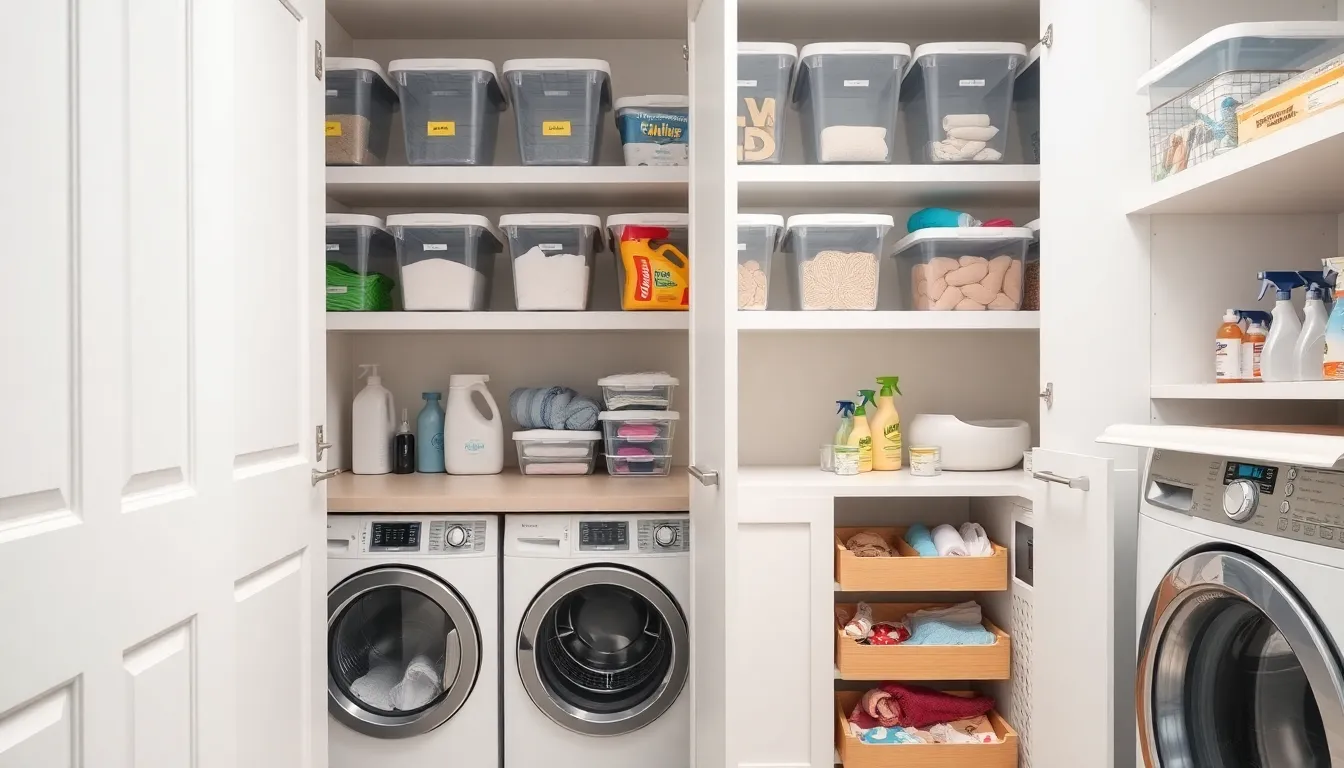
Organizational accessories transform your laundry room from a cluttered space into a highly functional workspace. Strategic additions make retrieving supplies easier while maintaining the organized systems you’ve already established.
Install Pull-Out Drawers in Existing Cabinets
Pull-out drawers increase accessibility in your existing cabinet space by eliminating the need to rummage through deep cabinets. We recommend installing these sliding drawer systems in lower cabinets where you store bulk supplies or frequently used items. The drawers extend fully, allowing you to see and reach items stored in the back corners of your cabinets.
Installing pull-out drawers directly into your current cabinetry provides immediate access to laundry supplies without requiring a complete renovation. Full-extension slides ensure the entire drawer contents remain visible and reachable. We suggest installing multiple shallow drawers rather than one deep drawer to better organize different types of products.
Cabinet manufacturers offer retrofit kits that fit most standard cabinet openings, making installation straightforward for most homeowners. Soft-close mechanisms prevent slamming and protect both the drawer contents and cabinet structure. Heavy-duty slides support the weight of detergent bottles and other substantial laundry supplies.
Use Clear Containers for Small Item Storage
Clear containers allow you to quickly identify contents without opening multiple storage answers. We recommend using plastic or glass containers for storing small items like clothespins, dryer sheets, stain removal pens, and measuring cups. The transparency eliminates guesswork and reduces time spent searching for exact supplies.
Standardized container sizes create a uniform appearance while maximizing shelf space efficiency. Square or rectangular containers use space better than round ones, fitting more items in the same storage area. Airtight seals on these containers protect contents from moisture and keep powdered detergents fresh longer.
Stackable designs multiply your storage capacity vertically without requiring additional shelf space. We suggest choosing containers with wide openings for easy access to frequently used items. Different sized containers accommodate various products, from small fabric softener sheets to larger items like wool dryer balls.
Add Labels to Every Storage Container and Shelf
Labels ensure every family member knows where each item belongs, promoting consistency throughout your organized laundry room. We recommend labeling every storage container, shelf, and designated area to maintain the organizational systems you’ve established. Clear, readable labels eliminate confusion and prevent supplies from being misplaced.
Waterproof labels withstand the humid laundry room environment without peeling or fading over time. We suggest using a label maker for professional-looking, uniform labels that enhance your room’s organized appearance. Font sizes should be large enough for quick reading while sorting or retrieving supplies.
Color-coded labels help family members quickly locate exact product categories. Different colored labels can designate washing supplies, drying products, stain treatments, and specialty cleaners. Picture labels work well for younger family members who may not read fluently yet still want to help with laundry organization.
Consistent labeling placement creates visual harmony throughout your storage areas. We recommend positioning labels at the same height and location on each container for a streamlined look. Regular label maintenance ensures they remain legible and securely attached to prevent organizational breakdown.
Maintain Your Laundry Room Organization System
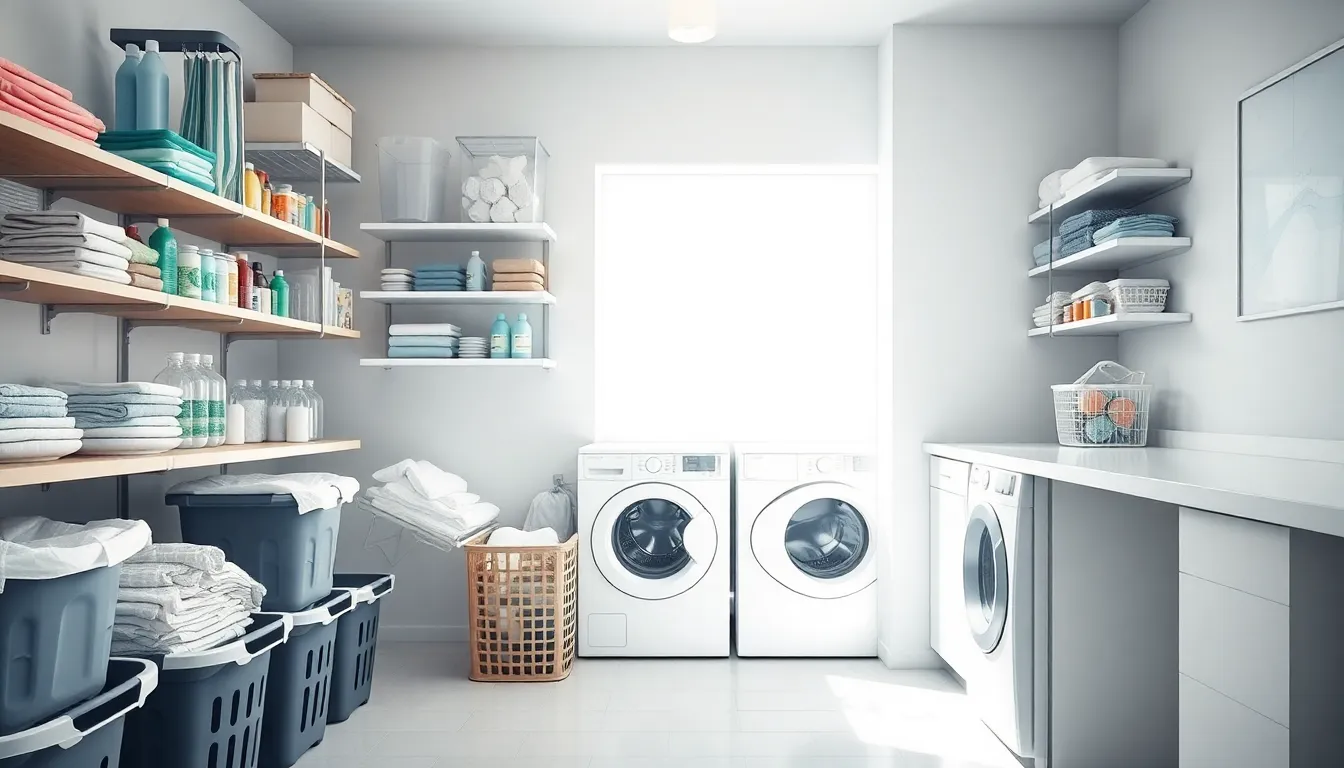
Creating an organized laundry room is just the beginning. We need consistent maintenance practices to keep our systems functioning effectively over time.
Establish Daily Tidying Routines
Daily tidying prevents clutter buildup and maintains the organized systems we’ve established. Setting aside just five minutes each evening to return supplies to their designated zones keeps our laundry room functional.
Putting away detergents immediately after use prevents countertop clutter from accumulating. We should fold and remove clean clothes from the staging area as soon as possible to maintain our workflow efficiency.
Wiping down surfaces after each laundry session removes soap residue and prevents sticky buildup on our storage containers. Loading dirty clothes directly into the appropriate sorting hampers eliminates the need for later reorganization.
Checking our pre-treatment station daily ensures stain removal supplies remain accessible and ready for immediate use. We can quickly restock any depleted items during these brief daily checks.
Schedule Weekly Deep Cleaning Sessions
Weekly deep cleaning maintains our laundry room’s functionality and extends the life of our organizational systems. Dedicating 30 minutes each week to thorough cleaning prevents dust and grime from compromising our storage answers.
Dusting our shelving units and storage containers keeps them looking fresh and prevents buildup that can make items difficult to access. We should vacuum the floor space thoroughly, including areas behind and around our washer and dryer.
Sanitizing surfaces removes detergent residue and prevents the sticky films that can make our organizational accessories less effective. Cleaning the interior of our storage containers ensures they remain hygienic for holding cleaning supplies.
Emptying and reorganizing our lost sock collection point during these sessions prevents it from becoming overcrowded. We can also use this time to match any found sock pairs and return them to circulation.
Review and Adjust Storage Answers Quarterly
Quarterly reviews ensure our storage answers continue meeting our family’s changing needs. Seasonal adjustments help optimize our laundry room organization as our routines and product preferences evolve.
Assessing the effectiveness of our current storage zones identifies areas where improvements can enhance efficiency. We might discover that frequently used items need repositioning to more accessible locations.
Rearranging shelf heights accommodates new products or changing storage requirements without requiring major renovations. Adding new organizational accessories can address any gaps in our current system.
Evaluating our sorting system helps determine if additional hampers or different categories would improve our workflow. We should also check that our labeling remains clear and that family members can easily locate items using our organizational system.
Conclusion
Creating an organized laundry room transforms daily chores from frustrating tasks into efficient routines. We’ve walked through practical strategies that work with any budget and space size – from smart storage answers to maintenance systems that keep everything running smoothly.
The key to success lies in consistency. By implementing these organizing principles and sticking to regular maintenance routines we can ensure our laundry spaces remain functional and stress-free for years to come.
Remember that organization isn’t about perfection – it’s about creating systems that work for your exact needs and lifestyle. Start with one area at a time and build momentum as you see the results.
Your newly organized laundry room will save you time reduce stress and make this necessary household task much more enjoyable. The investment in proper organization pays dividends every time you step into your transformed space.
Frequently Asked Questions
How often should I declutter my laundry room?
You should do a major declutter when your laundry room feels chaotic or overflowing. For maintenance, implement quarterly reviews to assess your storage solutions and remove expired products. Daily tidying routines and weekly deep cleaning sessions will help prevent clutter from building up and keep your organized system functioning effectively.
What are the most common clutter culprits in laundry rooms?
The biggest clutter culprits include unmatched socks, expired cleaning products, unused or duplicate detergents, broken laundry baskets, old fabric softener sheets, and cleaning supplies you never use. Empty containers, lint-covered items, and seasonal products mixed with daily essentials also contribute to laundry room chaos.
How do I organize laundry supplies without spending a lot of money?
Use clear containers you already have for grouping similar products, repurpose baskets for sorting, and install simple wall-mounted shelving. Create designated zones using existing furniture, use pegboards for hanging tools, and label everything with waterproof labels. Focus on maximizing vertical space with affordable floating shelves and rolling carts.
What’s the best way to sort laundry supplies for easy access?
Group similar items together: separate liquid and powder detergents, keep fabric softeners with dryer sheets, and store pre-treatment products at eye level. Place daily-use items in easily accessible spots, store seasonal supplies separately, and organize stain removal tools by stain type for quick response during emergencies.
How can I maximize storage in a small laundry room?
Focus on vertical space with wall-mounted shelving, over-the-washer cabinets, and pegboards for tools. Use stackable clear bins, rolling carts that fit between appliances, and corner shelving units. Install pull-out drawers in existing cabinets and consider multi-level storage solutions to make the most of every inch available.
Should I keep all my cleaning products in the laundry room?
Keep only products you regularly use for laundry tasks. Store daily essentials like detergent, fabric softener, and stain removers in the laundry room. Move specialty cleaners used occasionally to other storage areas, and separate seasonal items from everyday supplies to prevent overcrowding and maintain easy access to frequently used products.
How do I maintain an organized laundry room long-term?
Establish daily routines like returning supplies to designated zones and wiping surfaces after each use. Schedule weekly deep cleaning to prevent dust buildup, and conduct quarterly reviews to adjust storage solutions. Always put items back in their designated spots immediately and check expiration dates regularly to prevent accumulation of unused products.
What storage solutions work best for different laundry room layouts?
For narrow rooms, use vertical wall storage and rolling carts. In square rooms, try corner shelving and central islands. Small rooms benefit from over-appliance cabinets and pegboards. Regardless of layout, focus on eye-level storage for frequently used items, clear containers for visibility, and designated zones for different supply categories.
















